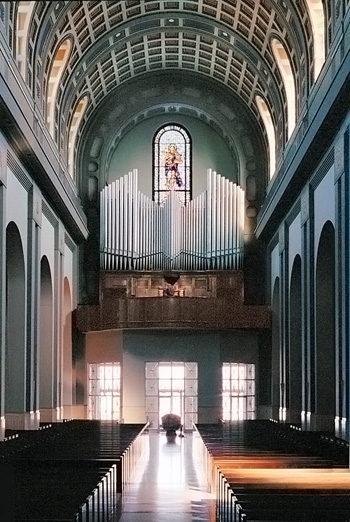 |
||
|
|
|
Celebrating the pipe organ, the King of Instruments |
Organ Profile
 1931 Steinmeyer organ at the Cathedral of the Blessed Sacrament in Altoona, PA
1931 Steinmeyer organ at the Cathedral of the Blessed Sacrament in Altoona, PA
Images by William van Pelt
This German-made organ was a gift of Annie C. Wolf in memory of her husband, Charles. The consultant was Msgr. Ludwig Berberich, organist and choirmaster of the Munich Frauenkirche - hence the recommendation to purchase an organ built in south Germany. The Steinmeyer firm dated back to 1847 and became in the late 19th century one of the leading organbuilding companies of Europe, with important organs in many important churches. The Altoona organ was at the time unlike any American organ, and despite its rather remote location, it had an important influence on such organbuilding figures as G. Donald Harrison and Senator Emerson Richards. Some of the characteristics that set it apart were: no extensions of any kind and only four manual stops borrowed into the Pedal; a high proportion of mixtures and independent mutations; no 8′ nontapered open flutes; unusual German antique reeds, such as the Eupohone, Krummhorn, and Kopfregal; lavish use of substantial tin; elegant pipe construction, such as use of Roman mouths for many interior pipes; no particularly loud stops; and equal dynamic balance among Great, Swell, and Pedal choruses. The unchanged instrument was restored in 1990-92 by Columbia Organ Works, according to historical guidelines. The only modification was the addition of a solid-state combination action and pistons to the console to augment the original, restored combination system made up of three free combinations activated by three tiny levers located above each stop.
Programs that feature this organ
 Max and Johann (#2011)
Max and Johann (#2011) Wait, oh Wait! (#2048)
Wait, oh Wait! (#2048) Bach On the Bench (#0511)
Bach On the Bench (#0511) Bach On the Bench (#0827)
Bach On the Bench (#0827) Gloria! (#0905)
Gloria! (#0905) From Palms to Passiontide (#0913)
From Palms to Passiontide (#0913)


